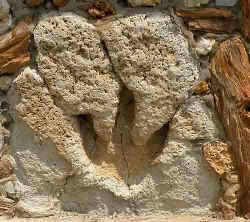Nov 5 2009
Data for 110-million-year old track will be available for download
Using portable 3D laser technology, scientists have electronically preserved a rare 110 million-year-old fossilized dinosaur footprint that was previously excavated and built into the wall of a bandstand at a Texas courthouse in the 1930s.
 110 Million-Year-Old Rare Dinosaur Footprint
110 Million-Year-Old Rare Dinosaur Footprint
The laser image preserves a "type specimen" footprint — an original track used to describe a species of dinosaur identified in the 1930s as ichnospecies Eubrontes glenrosensis, says paleontologist Thomas L. Adams at Southern Methodist University in Dallas.
Portable 3D laser scanners capture original fossil morphology and texture, making it possible to use the data for rapid 3D prototyping in foam or resin, Adams says.
Without prototyping, the shape of the original track might ultimately be lost. The footprint embedded in the bandstand has been exposed to the elements for nearly 75 years, causing portions of it to erode, Adams says. Erosional loss has affected the outer edge of the toes and heel, altering the initial shape of the track impression.
The track of the ichnospecies Eubrontes glenrosensis was originally excavated in 1933 from a main track layer in a riverbed in what is now 1,500-acre Dinosaur Valley State Park in North Central Texas. Not long after it was excavated, the citizens of Glen Rose built a stone bandstand and embedded the track in one of its walls.
The track was described in 1935 by Ellis W. Shuler, SMU's first geology professor.
Adams says the footprint is that of a three-toed, bipedal, meat-eating dinosaur, with the most likely candidate being the theropod named Acrocanthosaurus, found mostly in Texas, North Carolina and Oklahoma.
"The track is scientifically very important," says Adams, who is earning his doctoral degree in paleontology at SMU. "But it's also a historical and cultural icon for Texas."
Dinosaur Valley State Park boasts the ancient shoreline of a 113 million-year-old sea and is renowned for some of the best preserved dinosaur footprints in the world. The bandstand track is a popular draw for tourists passing through Glen Rose, which is an hour southwest of Dallas.
In an effort to preserve the specimen, as well as to compare its present state with the original description, Adams used a portable 3D laser scanner to perform in situ digitization of the track.
The scans were post-processed to generate high-resolution 3D digital models of the track. Finally the models were rendered in various media formats such as Quicktime VR Virtual Reality and Tagged Image File Format for viewing, publication and archival purposes.
Adams will make the raw scan data and industry-standard 3D object files format available for download.
The research demonstrates the advantages of using portable laser scanners to capture field data and create high-resolution, interactive models that can be digitally archived and made accessible to others via the Internet for further research and education.
"It's a nice way to share scientific data," Adams says.